Predicting Flood Frequency with the LH-Moments Method: A Case Study of Prigor River, Romania
Abstract
:1. Introduction
2. Methods
2.1. Probability Distributions
2.2. Parameter Estimation
2.2.1. Pearson V (PV)
- if :
- if :
2.2.2. CHI
- if :
- if :
2.2.3. Inverse CHI (ICH)
- if :
- if :
2.2.4. Wilson–Hilferty (WH)
- if :
- if :
2.2.5. Pseudo-Weibull (PW)
2.2.6. Log-Normal (LN3)
2.2.7. Generalized Pareto Type I (PGI)
2.2.8. Fréchet (FR)
- if :
- if :
3. Case Study
4. Results
5. Discussion
6. Conclusions
Author Contributions
Funding
Data Availability Statement
Conflicts of Interest
Abbreviations
| MOM | the method of ordinary moments |
| L-moments | the method of linear moments |
| LH-moments | the method of higher-order linear moments |
| linear moments | |
| higher-order linear moments | |
| coefficient of variation based on the L-moments method | |
| coefficient of skewness based on the L-moments method | |
| coefficient of kurtosis based on the L-moments method | |
| coefficient of variation based on the LH-moments method | |
| coefficient of skewness based on the LH-moments method | |
| coefficient of kurtosis based on the LH-moments method | |
| PV | Pearson V distribution |
| CHI | CHI distribution |
| ICH | inverse CHI distribution |
| WH | Wilson–Hilferty distribution |
| PW | Pseudo-Weibull distribution |
| LN3 | three-parameter Log-normal distribution |
| GPI | generalized Pareto Type I distribution |
| FR | three-parameter Fréchet distribution |
Appendix A. Parameter Estimation Using the Second-Order LH-Moments
- if :
- if :
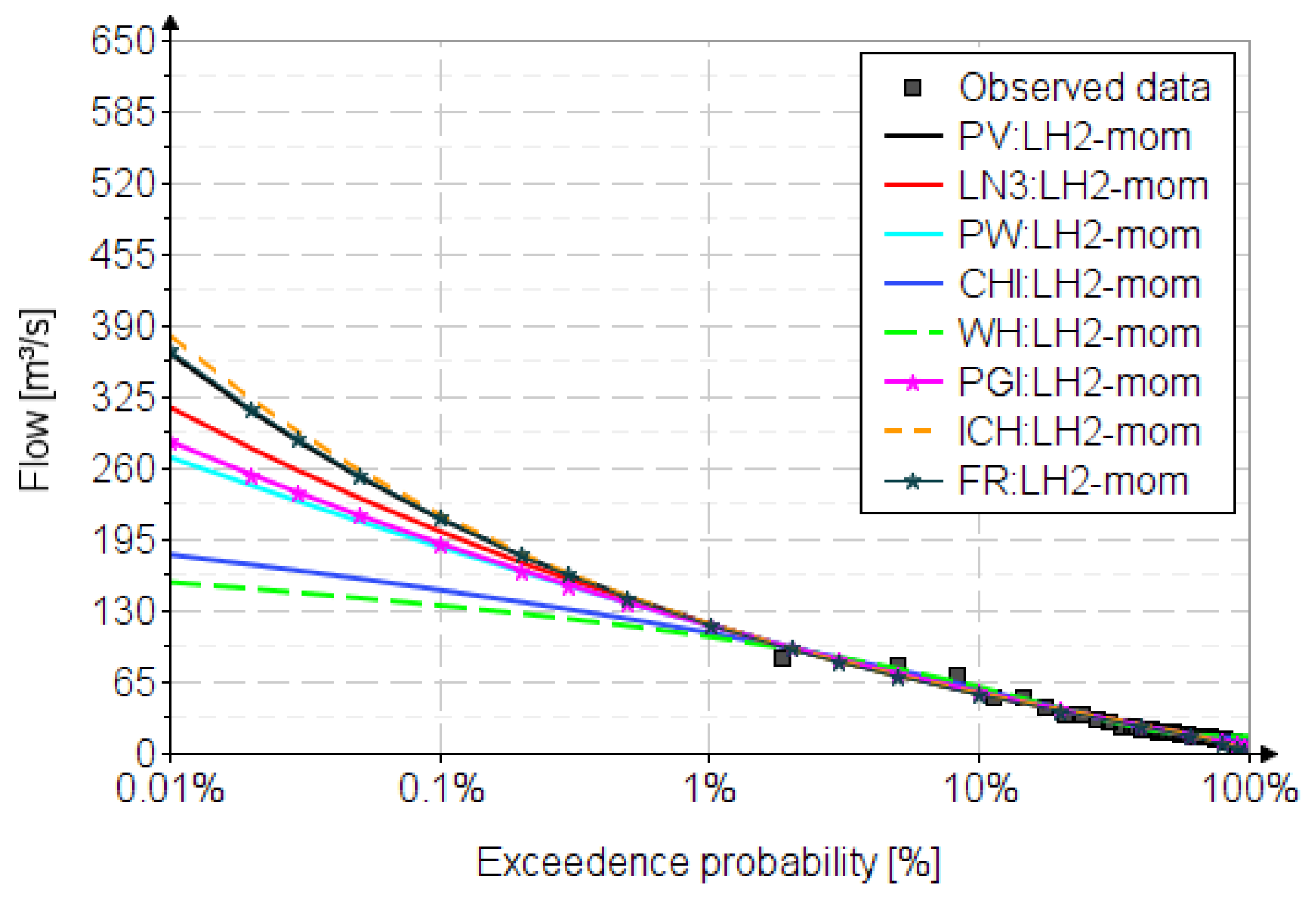
Appendix B. The Frequency Factors for the Analyzed Distributions
| Distr. | ||
|---|---|---|
| Quantile Function (Inverse Function) | ||
| LH-Moments (First Order) | LH-Moments (Second Order) | |
| PV | the expressions for and are explained in Section 2.2.1 | the expressions for and are explained in Appendix A |
| CHI | the expressions for and are explained in Section 2.2.4 | the expressions for and are explained in Appendix A |
| ICH | the expressions for and are explained in Section 2.2.3 | the expressions for and are explained in Appendix A |
| WH | the expressions for and are explained in Section 2.2.4 | the expressions for and are explained in Appendix A |
| PW | the expressions for and are explained in Section 2.2.5 | the expressions for and are explained in Appendix A |
| LN3 | the expressions for and are explained in Section 2.2.6 | the expressions for and are explained in Appendix A |
| PGI | ||
| FR | ||
Appendix C. The First-Order LH-Moments Diagram
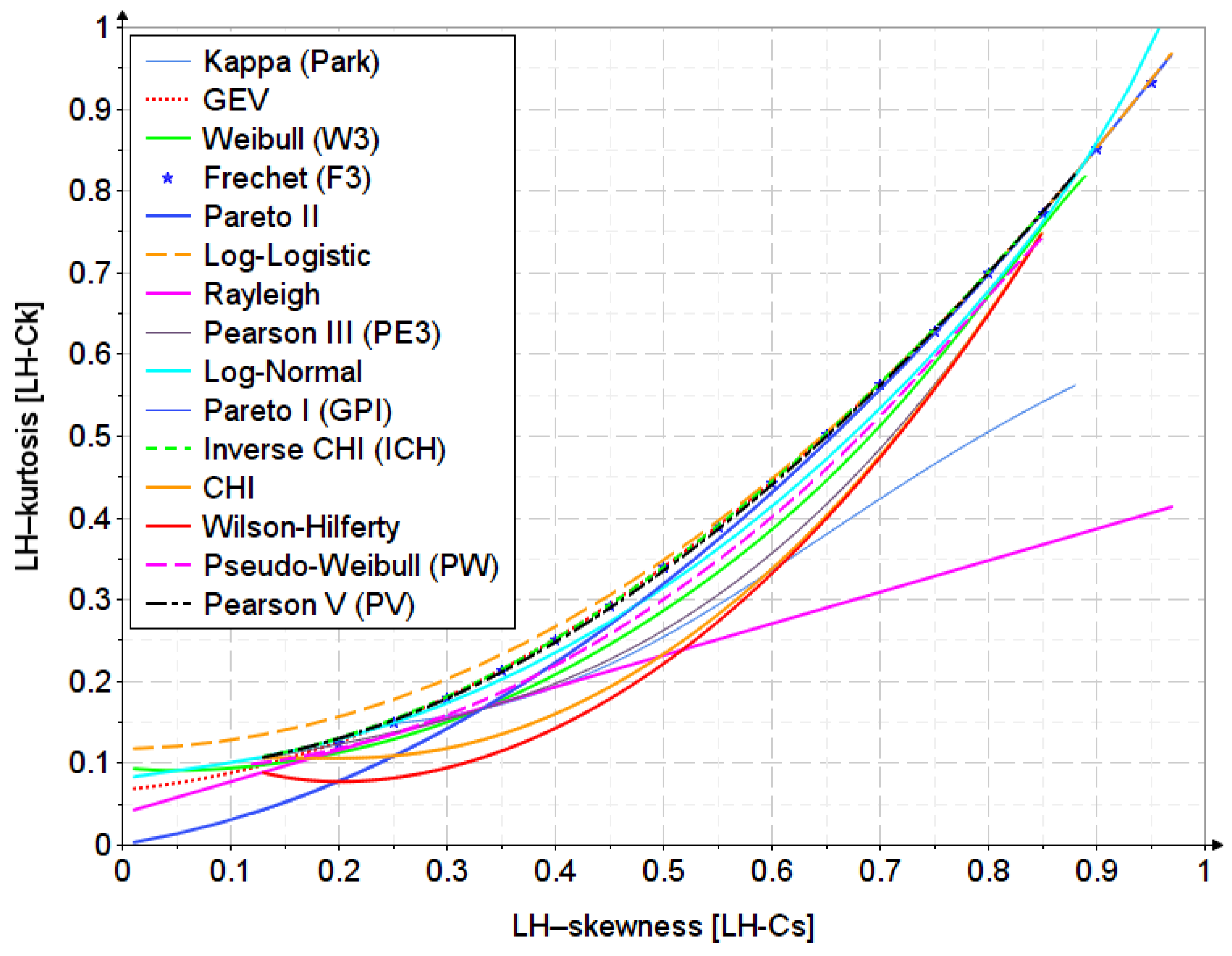
Appendix D. The Second-Order LH-Moments Diagram
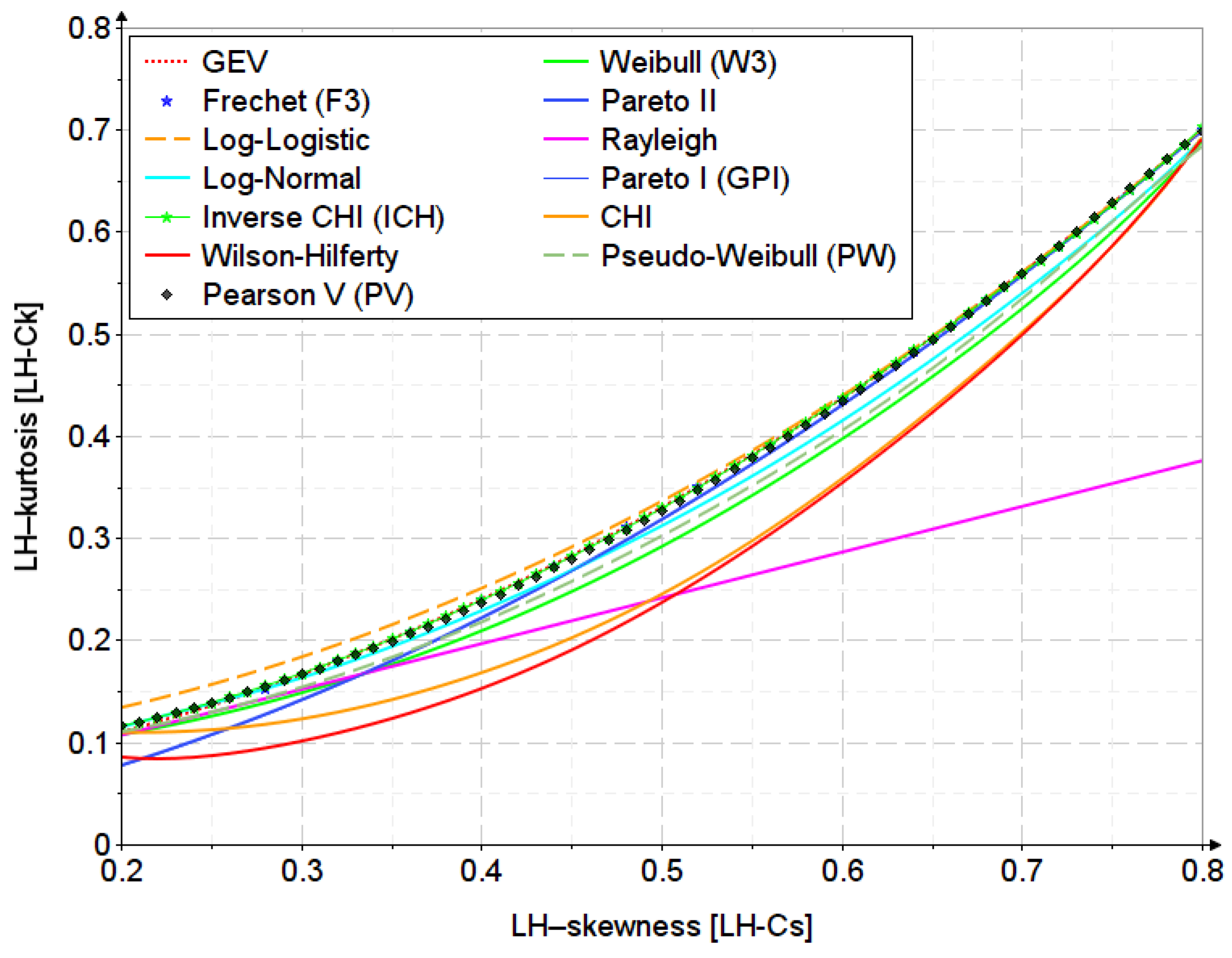
Appendix E. Estimation of the Frequency Factor for the PV Distribution
| P (%) | a | b | c | d | e | f | g | h |
|---|---|---|---|---|---|---|---|---|
| 0.01 | 11.25716 | −131.20350 | 1949.68567 | −11,151.25939 | 37,380.04905 | −68,646.56566 | 70,412.75359 | −29,839.17905 |
| 0.1 | 5.95329 | 5.28685 | 105.58814 | −116.64929 | −37.55278 | 1085.44951 | −1235.53789 | 185.05204 |
| 0.5 | 5.20696 | −6.34402 | 171.13982 | −663.09642 | 1552.89993 | −1826.49212 | 975.79402 | −210.37970 |
| 1 | 4.67849 | −6.34289 | 145.23208 | −593.97206 | 1402.57612 | −1769.23389 | 1073.27459 | −257.35685 |
| 2 | 4.09166 | −5.72542 | 113.45047 | −479.90312 | 1119.04640 | −1438.61769 | 917.93954 | −231.36365 |
| 3 | 3.72488 | −5.34813 | 95.45312 | −411.10312 | 948.26394 | −1217.30511 | 786.82014 | −201.56570 |
| 5 | 3.23329 | −4.91688 | 74.39560 | −328.29622 | 747.90220 | −951.38916 | 618.18166 | −160.15142 |
| 10 | 2.49248 | −4.33153 | 48.49037 | −222.21910 | 502.38567 | −628.82146 | 406.76300 | −105.78320 |
| 20 | 1.61367 | −3.50095 | 24.39044 | −116.57543 | 265.83072 | −329.17366 | 211.21241 | −54.80899 |
| 40 | 0.46069 | −1.90237 | 0.28296 | −2.20461 | 6.47671 | −7.31658 | 4.39076 | −1.18922 |
| 50 | −0.02947 | −1.00147 | −8.04637 | 38.61740 | −88.73004 | 111.53103 | −71.90978 | 18.57044 |
| 80 | −1.63651 | 3.08779 | −30.87890 | 144.26162 | −339.62037 | 429.40736 | −277.82412 | 72.21398 |
| 90 | −2.46681 | 5.99191 | −42.14745 | 187.59670 | −439.64825 | 556.34369 | −360.55393 | 93.89877 |
| P (%) | a | b | c | d | e | f | g | h |
|---|---|---|---|---|---|---|---|---|
| 0.01 | 81.910475 | −1771.514355 | 16,819.397533 | −82,805.460187 | 235,276.652260 | −386,190.499025 | 346,280.769342 | −130,055.21879 |
| 0.1 | 2.228731 | 59.123754 | −391.394621 | 1911.377627 | −4602.449696 | 6513.540173 | −4024.546602 | 352.304188 |
| 0.5 | 3.512205 | 12.804180 | −28.860341 | 198.686814 | −458.874164 | 782.400511 | −811.234773 | 272.458238 |
| 1 | 3.314992 | 7.768633 | −2.463356 | 39.354768 | −38.467754 | 15.733888 | −88.865312 | 49.856120 |
| 2 | 2.925506 | 5.809312 | −5.173311 | 30.048369 | −37.998837 | −28.905010 | 31.467196 | −5.026159 |
| 3 | 2.655839 | 4.814207 | −8.278126 | 36.412452 | −73.682802 | 34.281005 | 1.400566 | −2.325368 |
| 5 | 2.277429 | 3.322797 | −9.645991 | 35.521977 | −91.128870 | 89.977174 | −41.449511 | 8.012619 |
| 10 | 1.656367 | 1.012819 | −7.248799 | 18.654250 | −56.540573 | 76.866583 | −48.609237 | 12.214375 |
| 20 | 0.806822 | −1.031876 | −3.526086 | 2.999739 | −6.727668 | 15.136075 | −13.329765 | 4.178605 |
| 40 | −0.520195 | −2.007167 | 0.079953 | 0.896835 | 5.241720 | −10.751092 | 7.944665 | −2.160109 |
| 50 | −1.161667 | −1.793933 | 1.853417 | −0.018740 | 3.201880 | −8.323464 | 7.222178 | −2.214021 |
| 80 | −3.651550 | 2.664287 | 5.060010 | −17.180213 | 27.188778 | −26.520914 | 14.982105 | −3.714598 |
| 90 | −5.224593 | 8.397516 | −2.422149 | −17.374685 | 41.178694 | −46.186319 | 27.185834 | −6.714774 |
Appendix F. Estimation of the Frequency Factor for the ICH Distribution
| P (%) | a | b | c | d |
|---|---|---|---|---|
| 0.01 | 6.52997 | 26.82067 | 14.85657 | 464.96943 |
| 0.1 | 5.44941 | 17.20176 | 11.39250 | 177.19999 |
| 0.5 | 4.55112 | 11.16190 | 4.43462 | 72.13282 |
| 1 | 4.11304 | 8.70764 | 1.40446 | 44.77481 |
| 2 | 3.63324 | 6.34343 | −1.21804 | 25.78376 |
| 3 | 3.32837 | 5.00664 | −2.44115 | 17.89105 |
| 5 | 2.91207 | 3.38007 | −3.53519 | 10.69300 |
| 10 | 2.27033 | 1.30825 | −3.99266 | 4.64115 |
| 20 | 1.49234 | −0.51235 | −2.92430 | 1.11878 |
| 40 | 0.45076 | −1.78115 | 0.04530 | −2.15319 |
| 50 | 0.00178 | −1.91764 | 1.40809 | −3.60146 |
| 80 | −1.49132 | −0.60439 | 3.68532 | −7.00379 |
| 90 | −2.27256 | 1.15360 | 2.18165 | −5.73713 |
| P (%) | a | b | c | d | e | f | g | h |
|---|---|---|---|---|---|---|---|---|
| 0.01 | 79.883758 | −1679.417954 | 15,661.299605 | −76,196.141845 | 215,236.713 | −351,779.05466 | 315,145.61355 | −118,719.36587 |
| 0.1 | 2.439485 | 54.257459 | −349.512901 | 1696.329214 | −3847.028237 | 5154.772004 | −2931.225766 | 45.180979 |
| 0.5 | 3.640380 | 11.167621 | −27.074245 | 238.032175 | −608.858332 | 991.975375 | −943.188586 | 306.114622 |
| 1 | 3.513630 | 4.477591 | 14.966696 | 9.106453 | −49.568623 | 100.765426 | −176.345385 | 79.786789 |
| 2 | 3.146844 | 1.734343 | 22.157049 | −55.650510 | 94.739536 | −129.454331 | 62.029820 | −5.334231 |
| 3 | 2.864035 | 0.848887 | 20.078952 | −62.468499 | 105.677263 | −139.464427 | 86.184870 | −18.314985 |
| 5 | 2.447099 | 0.004927 | 15.332281 | −58.814530 | 98.385355 | −117.730239 | 76.491903 | −19.179270 |
| 10 | 1.753158 | −0.896712 | 7.695230 | −41.884058 | 75.958313 | −82.338902 | 50.779609 | −13.064095 |
| 20 | 0.834726 | −1.534456 | 0.288985 | −13.264633 | 32.253908 | −36.485557 | 21.964914 | −5.564021 |
| 40 | −0.531047 | −1.730709 | −2.509832 | 12.719488 | −22.304466 | 23.482121 | −13.881077 | 3.482139 |
| 50 | −1.176148 | −1.474153 | −0.968034 | 12.970906 | −28.143980 | 32.298762 | −19.777144 | 5.041014 |
| 80 | −3.667051 | 2.829186 | 4.750684 | −19.036152 | 35.510723 | −39.892243 | 24.957853 | −6.634231 |
| 90 | −5.248541 | 8.651554 | −2.624214 | −24.417599 | 70.138835 | −93.925739 | 63.986862 | −17.749432 |
Appendix G. Estimation of the Frequency Factor for the LN3 Distribution
| P (%) | a | b | c | d | e | f | g | h | i |
|---|---|---|---|---|---|---|---|---|---|
| 0.01 | 7.34577 | −11.93543 | 716.47126 | −4366.76433 | 13,233.45376 | −17,502.29426 | 9087.37090 | 0.13890 | −0.31483 |
| 0.1 | −182.8854 | 80,948.57367 | 69,705.91443 | 29,162.82665 | −47,509.61155 | −40,863.74927 | −86,394.5813 | 13,007.97382 | −22,817.9312 |
| 0.5 | 4.46079 | 768.03648 | 392.38804 | 2614.73022 | −5453.94909 | 4471.71101 | −2769.46863 | 161.69088 | −188.52368 |
| 1 | 5.05392 | 3381.94490 | 4190.83018 | 1683.11151 | −4342.06310 | −1032.28092 | −3834.14862 | 828.61007 | −638.47665 |
| 2 | 3.72540 | 559.11509 | 678.67334 | 283.47264 | −1231.65344 | 218.68686 | −530.59615 | 152.94462 | −60.42997 |
| 3 | 3.34676 | 268.95983 | 249.09931 | 62.99081 | −578.86038 | 94.48113 | −119.72659 | 79.34274 | −32.25046 |
| 5 | 2.90555 | 3.51178 | −4.44349 | 21.53572 | −56.29603 | 59.07715 | −27.31915 | −0.00055 | 0.00201 |
| 10 | 2.27392 | 10.31129 | 0.12209 | −25.46670 | 15.97668 | −30.11238 | 26.69439 | 4.08106 | −2.17704 |
| 20 | 1.47852 | 1457.8469 | −918.40881 | −2278.41631 | −529.77821 | 2130.23329 | −102.47085 | 977.02214 | −257.24175 |
| 40 | 0.44943 | −1.71341 | −0.58245 | −0.17569 | 2.15788 | −1.99608 | 0.85851 | − | − |
| 50 | −0.00005 | −1.81172 | −0.02237 | 0.94326 | −0.20718 | 0.17417 | −0.07598 | − | − |
| 80 | −1.49191 | −0.52177 | 1.78568 | −0.41759 | −0.93231 | 0.93656 | −0.35804 | − | − |
| 90 | −2.27165 | 1.17186 | 1.28540 | −1.61220 | 0.18629 | 0.49903 | −0.25817 | − | − |
| P (%) | a | b | c | d |
|---|---|---|---|---|
| 0.01 | 20.4560566 | 0.0157214 | 7.6751191 | 0.1690430 |
| 0.1 | 19.9223136 | 0.0157565 | 7.7306869 | 0.1694185 |
| 0.5 | 19.4863608 | 0.0157853 | 7.7760593 | 0.1697253 |
| 1 | 19.2751529 | 0.0157992 | 7.7980364 | 0.1698740 |
| 2 | 19.0445424 | 0.0158144 | 7.8220289 | 0.1700363 |
| 3 | 18.8983187 | 0.0158240 | 7.8372399 | 0.1701393 |
| 5 | 18.6989591 | 0.0158372 | 7.8579761 | 0.1702796 |
| 10 | 18.3922410 | 0.0158574 | 7.8898737 | 0.1704956 |
| 20 | 18.0212465 | 0.0158819 | 7.9284472 | 0.1707569 |
| 40 | 17.5258663 | 0.0159145 | 7.9799386 | 0.1711059 |
| 50 | 17.3127762 | 0.0159286 | 8.0020827 | 0.1712560 |
| 80 | 16.6059721 | 0.0159752 | 8.0755103 | 0.1717541 |
| 90 | 16.2371749 | 0.0159996 | 8.1138096 | 0.1720141 |
Appendix H. Estimation of the Frequency Factor for the FR Distribution
| P (%) | a | b | c | d | e | f | g | h |
|---|---|---|---|---|---|---|---|---|
| 0.01 | 4.79878 | −4.79613 | −6.32125 | 17.28586 | −25.92369 | 22.32216 | −10.40520 | 2.04267 |
| 0.1 | 4.60163 | −4.60769 | −4.90472 | 10.51612 | −12.27707 | 7.99307 | −2.64179 | 0.31910 |
| 0.5 | 4.22930 | −4.25399 | −3.71518 | 5.66451 | −3.27906 | −1.32316 | 2.62737 | −0.95280 |
| 1 | 3.91982 | −3.96379 | −3.31247 | 4.71382 | −2.66524 | −0.95161 | 1.98933 | −0.73158 |
| 2 | 3.54772 | −3.62982 | −2.86477 | 3.75946 | −2.06788 | −0.65905 | 1.46457 | −0.55126 |
| 3 | 3.29251 | −3.41148 | −2.58280 | 3.23198 | −1.80321 | −0.41053 | 1.11661 | −0.43379 |
| 5 | 2.92396 | −3.11434 | −2.19334 | 2.52840 | −1.27243 | −0.51770 | 1.05146 | −0.40659 |
| 10 | 2.31559 | −2.67844 | −1.61581 | 1.72570 | −0.89911 | −0.20951 | 0.61552 | −0.25426 |
| 20 | 1.53537 | −2.24054 | −0.93998 | 1.02318 | −0.49957 | −0.06099 | 0.30917 | −0.12674 |
| 40 | 0.45853 | −1.89670 | −0.07881 | 0.41672 | 0.13819 | −0.05952 | −0.06296 | 0.08501 |
| 50 | −0.00696 | −1.84955 | 0.26139 | 0.40009 | 0.16243 | 0.00554 | −0.01990 | 0.04712 |
| 80 | −1.52193 | 0.01607 | −0.14440 | 0.92152 | −0.44753 | 0.00190 | 0.33891 | −0.16508 |
| 90 | −2.28341 | 1.29295 | 0.04646 | 0.24771 | −0.28723 | −0.06346 | 0.06346 | −0.05894 |
| P (%) | a | b | c | d |
|---|---|---|---|---|
| 0.01 | 20.4560566 | 0.0157214 | 7.6751191 | 0.1690430 |
| 0.1 | 19.9223136 | 0.0157565 | 7.7306869 | 0.1694185 |
| 0.5 | 19.4863608 | 0.0157853 | 7.7760593 | 0.1697253 |
| 1 | 19.2751529 | 0.0157992 | 7.7980364 | 0.1698740 |
| 2 | 19.0445424 | 0.0158144 | 7.8220289 | 0.1700363 |
| 3 | 18.8983187 | 0.0158240 | 7.8372399 | 0.1701393 |
| 5 | 18.6989591 | 0.0158372 | 7.8579761 | 0.1702796 |
| 10 | 18.3922410 | 0.0158574 | 7.8898737 | 0.1704956 |
| 20 | 18.0212465 | 0.0158819 | 7.9284472 | 0.1707569 |
| 40 | 17.5258663 | 0.0159145 | 7.9799386 | 0.1711059 |
| 50 | 17.3127762 | 0.0159286 | 8.0020827 | 0.1712560 |
| 80 | 16.6059721 | 0.0159752 | 8.0755103 | 0.1717541 |
| 90 | 16.2371749 | 0.0159996 | 8.1138096 | 0.1720141 |
Appendix I. The Probability Density Functions and Complementary Cumulative Distribution Function
| Distribution | ||
|---|---|---|
| PV | ||
| CHI | ||
| ICH | ||
| WH | ||
| PW | ||
| LN3 | ||
| GPI | ||
| FR |
Appendix J. The Confidence Intervals of the Analysed Distributions
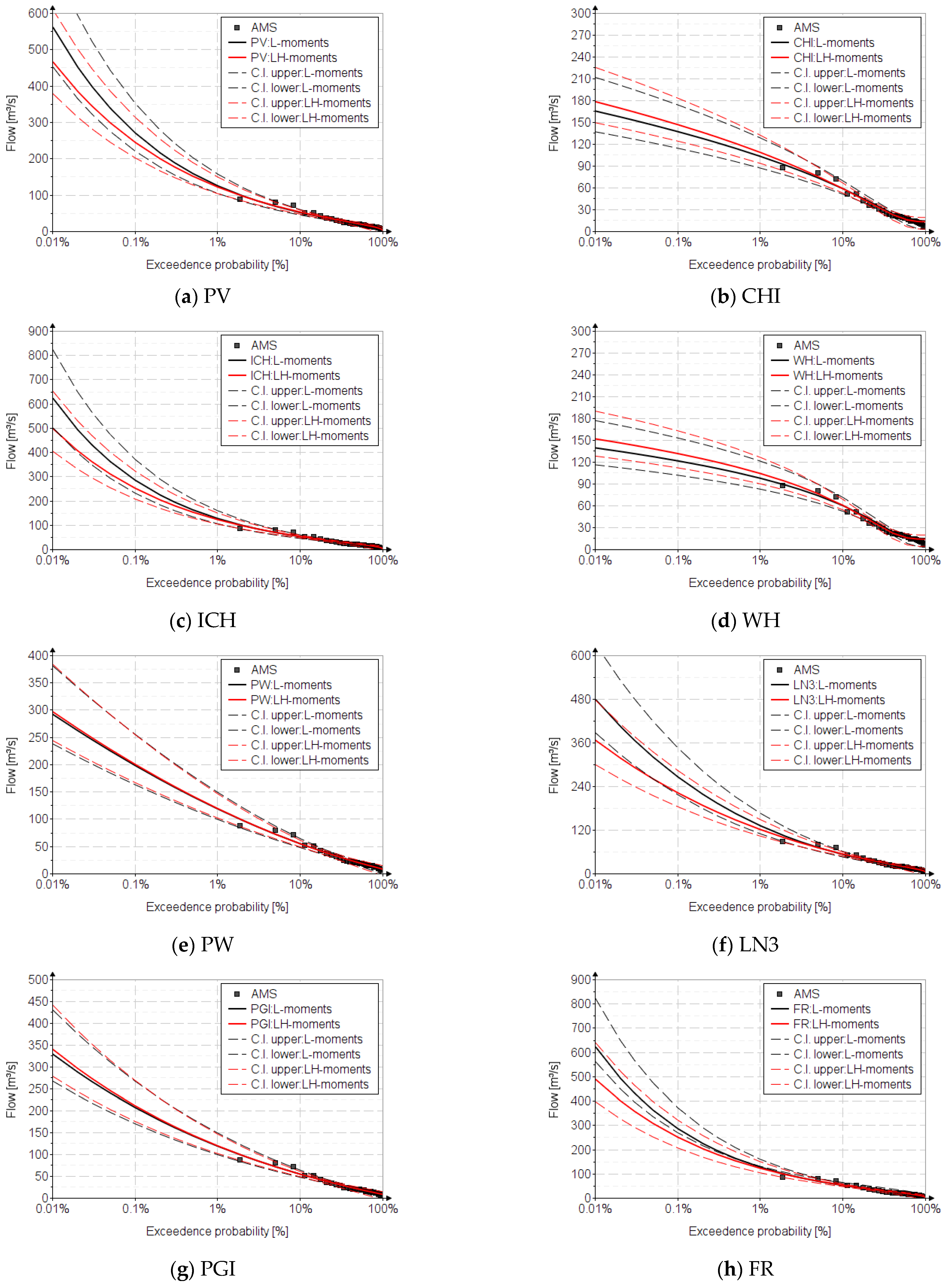
Appendix K. Built-In Function in Mathcad
References
- Wang, Q.J. LH moments for statistical analysis of extreme events. Water Resour. Res. 1997, 33, 2841–2848. [Google Scholar] [CrossRef]
- Hosking, J.R.M.; Wallis, J.R. Regional Frequency Analysis: An Approach Based on L–Moments; Cambridge University Press: Cambridge, UK, 1997. [Google Scholar] [CrossRef]
- Rao, A.R.; Hamed, K.H. Flood Frequency Analysis; CRC Press LLC: Boca Raton, FL, USA, 2000. [Google Scholar]
- Greenwood, J.A.; Landwehr, J.M.; Matalas, N.C.; Wallis, J.R. Probability Weighted Moments: Definition and Relation to Parameters of Several Distributions Expressable in Inverse Form. Water Resour. Res. 1979, 15, 1049–1054. [Google Scholar] [CrossRef]
- Hosking, J.R.M. L–moments: Analysis and Estimation of Distributions using Linear, Combinations of Order Statistics. J. R. Statist. Soc. 1990, 52, 105–124. [Google Scholar] [CrossRef]
- Houghton, J.C. Birth of a parent: The Wakeby distribution for modeling flood flows. Water Resour. Res. 1978, 14, 1105–1109. [Google Scholar] [CrossRef]
- Hewa, G.A.; Wang, Q.J.; McMahon, T.A.; Nathan, R.J.; Peel, M.C. Generalized extreme value distribution fitted by LH moments for low–flow frequency analysis. Water Resour. Res. 2007, 43, W06301. [Google Scholar] [CrossRef]
- Wang, Q.J. Approximate Goodness–of–Fit Tests of fitted generalized extreme value distributions using LH moments. Water Resour. Res. 1998, 34, 3497–3502. [Google Scholar] [CrossRef]
- Fawad, M.; Cassalho, F.; Ren, J.; Chen, L.; Yan, T. State–of–the–Art Statistical Approaches for Estimating Flood Events. Entropy 2022, 24, 898. [Google Scholar] [CrossRef]
- Lee, S.H.; Maeng, S.J. Comparison and analysis of design floods by the change in the order of LH–moment methods. Irrig. Drain. 2003, 52, 231–245. [Google Scholar] [CrossRef]
- Meshgi, A.; Khalili, D. Comprehensive evaluation of regional flood frequency analysis by L– and LH–moments. II. Development of LH–moments parameters for the generalized Pareto and generalized logistic distributions. Stoch. Environ. Res. Risk Assess. 2009, 23, 137–152. [Google Scholar] [CrossRef]
- Meshgi, A.; Khalili, D. Comprehensive evaluation of regional flood frequency analysis by L– and LH–moments. I. A revisit to regional homogeneity. Stoch. Environ. Res. Risk Assess. 2009, 23, 119–135. [Google Scholar] [CrossRef]
- Bhuyan, A.; Borah, M.; Kumar, R. Regional Flood Frequency Analysis of North–Bank of the River Brahmaputra by Using LH–Moments. Water Resour. Manag. 2010, 24, 1779–1790. [Google Scholar] [CrossRef]
- Nouri Gheidari, M.H. Comparisons of the L– and LH–moments in the selection of the best distribution for regional flood frequency analysis in Lake Urmia Basin. Civ. Eng. Environ. Syst. 2013, 30, 72–84. [Google Scholar] [CrossRef]
- Deka, S.; Borah, M.; Kakaty, S.C. Statistical analysis of annual maximum rainfall in North–East India: An application of LH–moments. Theor. Appl. Climatol. 2011, 104, 111–122. [Google Scholar] [CrossRef]
- Zakaria, Z.; Suleiman, J.; Mohamad, M. Rainfall frequency analysis using LH–moments approach: A case of Kemaman Station, Malaysia. Int. J. Eng. Technol. 2018, 7, 107–110. [Google Scholar] [CrossRef]
- Bora, D.J.; Borah, M.; Bhuyan, A. Regional analysis of maximum rainfall using L–moment and LH–moment: A comparative case study for the northeast India. Mausam 2017, 68, 451–462. [Google Scholar] [CrossRef]
- Ilinca, C.; Anghel, C.G. Flood–Frequency Analysis for Dams in Romania. Water 2022, 14, 2884. [Google Scholar] [CrossRef]
- Anghel, C.G.; Ilinca, C. Hydrological Drought Frequency Analysis in Water Management Using Univariate Distributions. Appl. Sci. 2023, 13, 3055. [Google Scholar] [CrossRef]
- Ilinca, C.; Anghel, C.G. Flood Frequency Analysis Using the Gamma Family Probability Distributions. Water 2023, 15, 1389. [Google Scholar] [CrossRef]
- Anghel, C.G.; Ilinca, C. Parameter Estimation for Some Probability Distributions Used in Hydrology. Appl. Sci. 2022, 12, 12588. [Google Scholar] [CrossRef]
- Md Sharwar, M.; Park, B.-J.; Jeong, B.-Y.; Park, J.-S. LH–Moments of Some Distributions Useful in Hydrology. Commun. Stat. Appl. Methods 2009, 16, 647–658. [Google Scholar]
- Gaume, E. Flood frequency analysis: The Bayesian choice. WIREs Water. 2018, 5, e1290. [Google Scholar] [CrossRef]
- Chow, V.T.; Maidment, D.R.; Mays, L.W. Applied Hydrology; McGraw–Hill, Inc.: New York, NY, USA, 1988; ISBN 007-010810-2. [Google Scholar]
- Bulletin 17B Guidelines for Determining Flood Flow Frequency; Hydrology Subcommittee; Interagency Advisory Committee on Water Data; U.S. Department of the Interior; U.S. Geological Survey; Office of Water Data Coordination: Reston, VA, USA, 1981.
- Bulletin 17C Guidelines for Determining Flood Flow Frequency; U.S. Department of the Interior; U.S. Geological Survey: Reston, VA, USA, 2017.
- Anghel, C.G.; Ilinca, C. Evaluation of Various Generalized Pareto Probability Distributions for Flood Frequency Analysis. Water 2023, 15, 1557. [Google Scholar] [CrossRef]
- Ministry of the Environment. The Romanian Water Classification Atlas, Part I—Morpho–Hydrographic Data on the Surface Hydrographic Network; Ministry of the Environment: Bucharest, Romania, 1992. [Google Scholar]
- Teodorescu, I.; Filotti, A.; Chiriac, V.; Ceausescu, V.; Florescu, A. Water Management; Ceres Publishing House: Bucharest, Romania, 1973. [Google Scholar]
- Ilinca, C.; Anghel, C.G. Frequency Analysis of Extreme Events Using the Univariate Beta Family Probability Distributions. Appl. Sci. 2023, 13, 4640. [Google Scholar] [CrossRef]
- Zhao, F.; Wang, X.; Wu, Y.; Singh, S.K. Prefectures vulnerable to water scarcity are not evenly distributed across China. Commun. Earth Environ. 2023, 4, 145. [Google Scholar] [CrossRef]
- Zhao, F.; Wang, X.; Wu, Y.; Sivakumar, B.; Liu, S. Enhanced Dependence of China’s Vegetation Activity on Soil Moisture Under Drier Climate Conditions. J. Geophys. Res. Biogeosci. 2023, 128, e2022JG007300. [Google Scholar] [CrossRef]


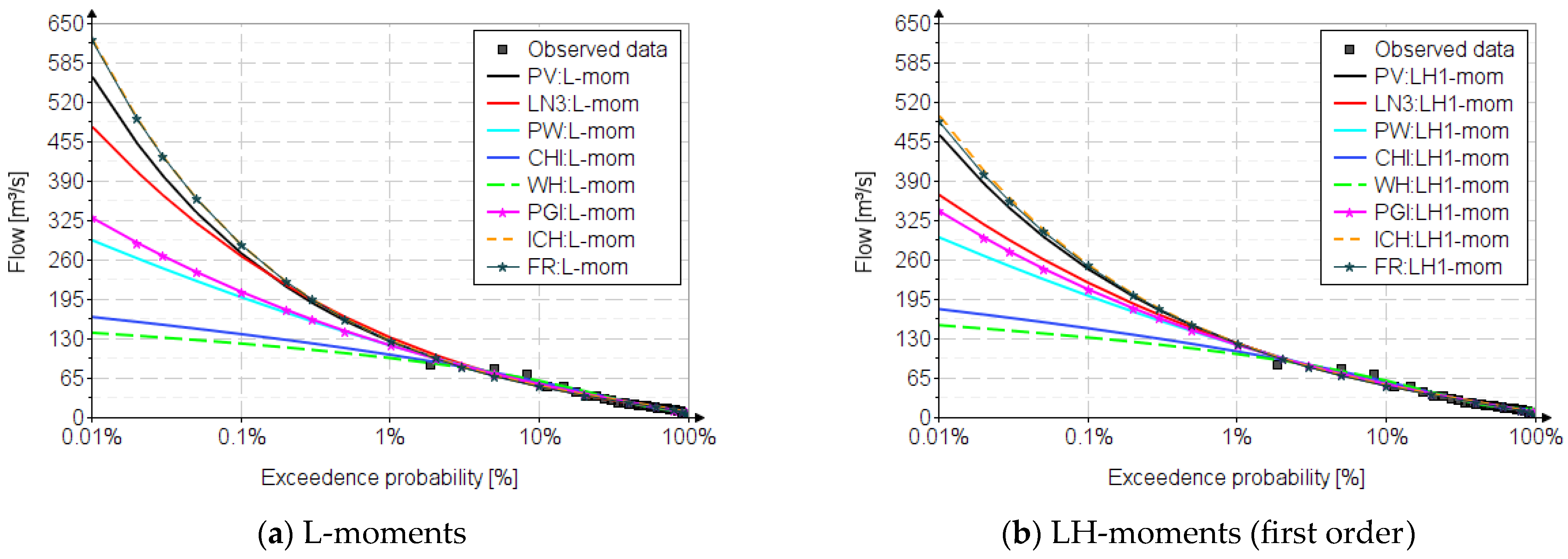
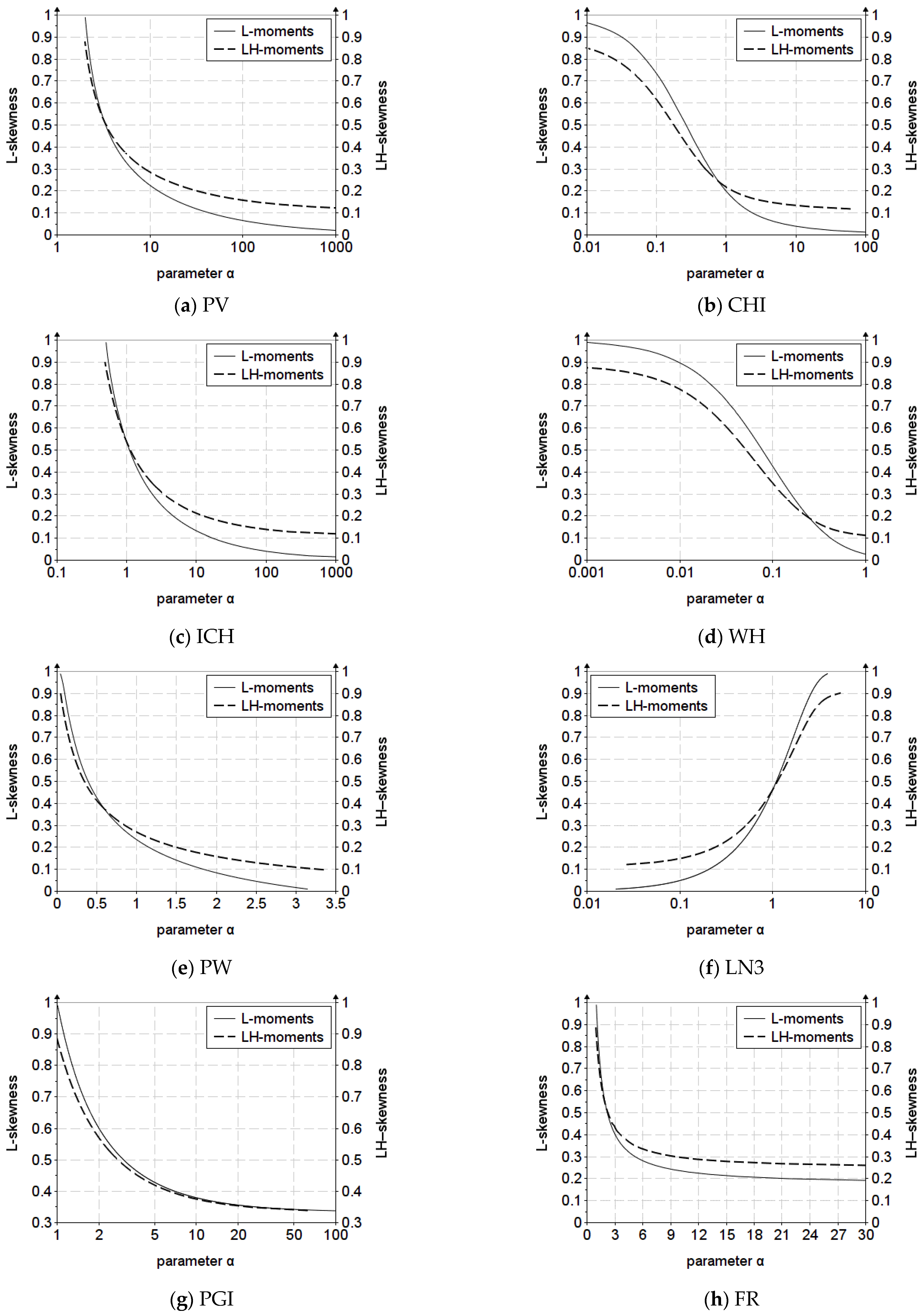
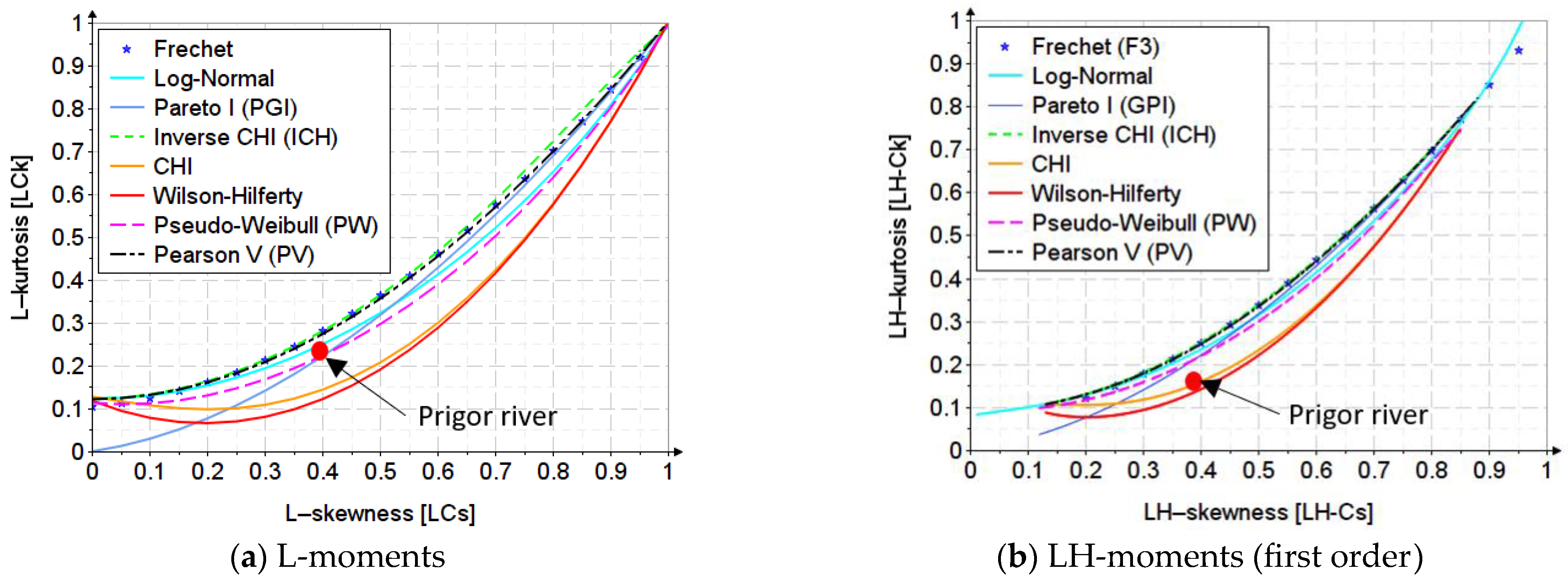
| New Elements | Method of Parameter Estimation |
|---|---|
| LH−Moments | |
| Exact parameter estimation | PV, CHI, ICH, WH, PW, PGI, FR |
| Approximate estimation of parameters | PV, CHI, ICH, WH, PW, PGI, FR, LN3 |
| Expression of the inverse function with the frequency factor | PV, CHI, ICH, WH, PW, PGI, FR |
| Exact relationships of the frequency factors | PV, CHI, ICH, WH, PW, PGI, FR |
| Approximate estimation of the frequency factors | PV, CHI, ICH, WH, PW, PGI, FR |
| The confidence interval with Chow’s relationship | PV, CHI, ICH, WH, PW, PGI, FR |
| The skewness−kurtosis variation graph and relationships | PV, CHI, ICH, WH, PW, PGI, FR |
| Distribution | Distribution | ||
|---|---|---|---|
| PV | WH | ||
| CHI | PW | ||
| LN3 | ICH | ||
| PGI | FR |
| Length (km) | Average Stream Slope (‰) | Sinuosity Coefficient (−) | Average Altitude (m) | Watershed Area (km2) |
|---|---|---|---|---|
| 33 | 22 | 1.83 | 713 | 153 |
| AMS | ||||||||||||
| 1990 | 1991 | 1992 | 1993 | 1994 | 1995 | 1996 | 1997 | 1998 | 1999 | 2000 | ||
| Flow | (m3/s) | 9.96 | 15 | 10.1 | 14.8 | 7.30 | 21.2 | 18.2 | 21.4 | 13.1 | 14.5 | 35 |
| 2001 | 2002 | 2003 | 2004 | 2005 | 2006 | 2007 | 2008 | 2009 | 2010 | 2011 | ||
| Flow | (m3/s) | 19.9 | 22.1 | 11.8 | 80.3 | 88 | 51.6 | 72.2 | 16.2 | 42.6 | 28.5 | 12.8 |
| 2012 | 2013 | 2014 | 2015 | 2016 | 2017 | 2018 | 2019 | 2020 | ||||
| Flow | (m3/s) | 31.2 | 24.1 | 52.2 | 21.1 | 18.9 | 6.40 | 24.9 | 15.1 | 36.6 | ||
| Prigor River | Statistical Indicators | ||||||
| L-moments | |||||||
| (m3/s) | (m3/s) | (m3/s) | (m3/s) | (−) | (−) | (−) | |
| 27.2 | 10.7 | 4.26 | 2.43 | 0.386 | 0.399 | 0.228 | |
| LH-moments (first order) | |||||||
| (m3/s) | (m3/s) | (m3/s) | (m3/s) | (−) | (−) | (−) | |
| 38.3 | 11.2 | 4.46 | 1.99 | 0.292 | 0.398 | 0.177 | |
| Distr. | Annual Maximum Series (AMS) | |||||||||||||||||
|---|---|---|---|---|---|---|---|---|---|---|---|---|---|---|---|---|---|---|
| Exceedance Probabilities (%) | ||||||||||||||||||
| L-Moments | LH-Moments (First Order) | |||||||||||||||||
| 0.01 | 0.1 | 0.5 | 1 | 2 | 3 | 5 | 80 | 90 | 0.01 | 0.1 | 0.5 | 1 | 2 | 3 | 5 | 80 | 90 | |
| PV | 562 | 270 | 159 | 125 | 97.2 | 83.6 | 68.5 | 12.4 | 9.63 | 467 | 244 | 151 | 121 | 96.5 | 83.7 | 69.4 | 11.4 | 8.16 |
| CHI | 165 | 137 | 114 | 103 | 90.9 | 83.4 | 73.4 | 11.1 | 10.4 | 178 | 147 | 121 | 108 | 94.9 | 86.4 | 75.1 | 13.4 | 13.2 |
| ICH | 624 | 284 | 162 | 126 | 97.5 | 83.5 | 68.2 | 12.4 | 9.46 | 498 | 251 | 152 | 122 | 96.2 | 83.3 | 70 | 11.4 | 7.94 |
| WH | 139 | 121 | 106 | 97.4 | 88.2 | 82.1 | 73.5 | 11.2 | 10.7 | 152 | 131 | 113 | 104 | 93.2 | 86.1 | 76.1 | 13.9 | 13.8 |
| PW | 292 | 198 | 141 | 118 | 97.4 | 85.8 | 72 | 11.8 | 9.64 | 297 | 200 | 142 | 119 | 97.7 | 86 | 72 | 11.9 | 9.82 |
| LN3 | 480 | 266 | 165 | 132 | 103 | 87.9 | 71.4 | 12.4 | 10.3 | 367 | 222 | 147 | 121 | 97.4 | 85 | 70.7 | 11.6 | 8.88 |
| GPI | 329 | 207 | 142 | 118 | 96.8 | 85.1 | 71.4 | 11.7 | 9.60 | 340 | 211 | 144 | 119 | 97.1 | 85.2 | 71.3 | 11.8 | 9.76 |
| FR | 623 | 285 | 162 | 126 | 97.7 | 83.6 | 68.2 | 12.4 | 9.47 | 489 | 250 | 152 | 122 | 96.3 | 83.5 | 69 | 11.4 | 7.90 |
| Annual Maximum Series (AMS) | ||||||||
|---|---|---|---|---|---|---|---|---|
| Parameters | Distribution | |||||||
| PV | CHI | ICH | WH | PW | LN3 | GPI | FR | |
| L-moments | ||||||||
| 4.3055 | 0.3887 | 1.5005 | 0.1099 | 0.5467 | 2.601 | 7.1344 | 3.0516 | |
| 69.4 | 44.4 | 32.3 | 73.2 | 2.41 | 0.9569 | 122 | 31.2 | |
| −2.46 | 10.3 | −8.83 | 10.7 | 7.23 | 6.34 | −114 | −14.2 | |
| LH-moments (first order) | ||||||||
| 4.8615 | 0.2929 | 1.7617 | 0.081 | 0.5375 | 2.894 | 6.6853 | 3.6925 | |
| 98.2 | 48.7 | 43.2 | 80.1 | 2.24 | 0.8072 | 112 | 42.5 | |
| −6.95 | 13.2 | −15.04 | 13.8 | 7.52 | 2.47 | −104 | −26.03 | |
| Distr. | Statistical Measures | |||||||||||
|---|---|---|---|---|---|---|---|---|---|---|---|---|
| Methods of Parameter Estimation | Observed Data | |||||||||||
| L-Moments | LH-Moments | L-Moments | LH-Moments | |||||||||
| RME | RAE | RME | RAE | |||||||||
| PV | 0.0152 | 0.0649 | 0.3987 | 0.2728 | 0.0188 | 0.0842 | 0.3981 | 0.2456 | 0.3987 | 0.2277 | 0.3981 | 0.1773 |
| CHI | 0.0301 | 0.1238 | 0.1438 | 0.0468 | 0.1367 | 0.1584 | ||||||
| ICH | 0.0151 | 0.0637 | 0.2797 | 0.0209 | 0.0912 | 0.2495 | ||||||
| WH | 0.0334 | 0.1382 | 0.1214 | 0.0521 | 0.1508 | 0.1408 | ||||||
| PW | 0.0173 | 0.0735 | 0.2219 | 0.018 | 0.0739 | 0.2175 | ||||||
| LN3 | 0.0199 | 0.0759 | 0.2800 | 0.0148 | 0.0673 | 0.2330 | ||||||
| GPI | 0.0181 | 0.0765 | 0.2211 | 0.0187 | 0.0766 | 0.2205 | ||||||
| FR | 0.0152 | 0.0636 | 0.2816 | 0.0213 | 0.0925 | 0.2499 | ||||||
Disclaimer/Publisher’s Note: The statements, opinions and data contained in all publications are solely those of the individual author(s) and contributor(s) and not of MDPI and/or the editor(s). MDPI and/or the editor(s) disclaim responsibility for any injury to people or property resulting from any ideas, methods, instructions or products referred to in the content. |
© 2023 by the authors. Licensee MDPI, Basel, Switzerland. This article is an open access article distributed under the terms and conditions of the Creative Commons Attribution (CC BY) license (https://creativecommons.org/licenses/by/4.0/).
Share and Cite
Anghel, C.G.; Ilinca, C. Predicting Flood Frequency with the LH-Moments Method: A Case Study of Prigor River, Romania. Water 2023, 15, 2077. https://doi.org/10.3390/w15112077
Anghel CG, Ilinca C. Predicting Flood Frequency with the LH-Moments Method: A Case Study of Prigor River, Romania. Water. 2023; 15(11):2077. https://doi.org/10.3390/w15112077
Chicago/Turabian StyleAnghel, Cristian Gabriel, and Cornel Ilinca. 2023. "Predicting Flood Frequency with the LH-Moments Method: A Case Study of Prigor River, Romania" Water 15, no. 11: 2077. https://doi.org/10.3390/w15112077






